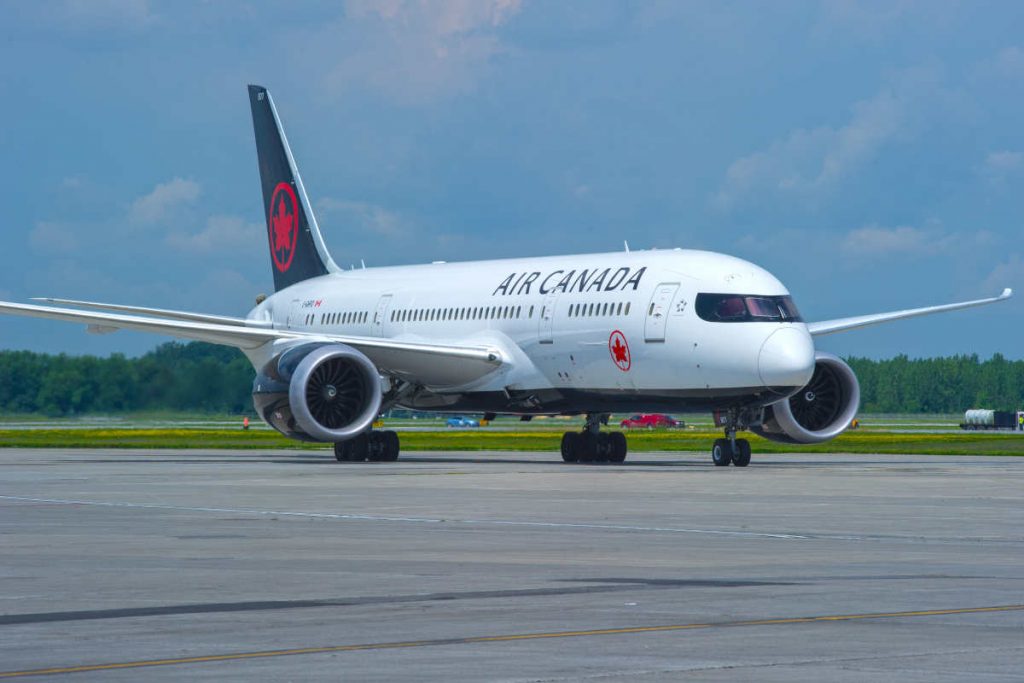
Features
Airlines
Air Canada reports first quarter, $1.05B net loss
“We are now living through the darkest period ever in the history of commercial aviation.”
May 4, 2020 By Wings Staff
 Air Canada 787 Dreamliner. (Photo: Air Canada)
Air Canada 787 Dreamliner. (Photo: Air Canada) Air Canada on May 4 reported its 2020 first quarter results, including a net loss of $1.05 billion when compared to the year ago quarter that generated a positive net income of $345 million. The initial quarter of 2020 was the first in 27 consecutive quarters in which Air Canada did not report year-over-year operating growth.
“Our first quarter results reflect the severity and abruptness of the impact that the COVID-19 pandemic has had on Air Canada, which started to be felt across the global airline industry in late January with the suspension by many carriers, including Air Canada, of services to China,” said Calin Rovinescu, president and CEO of Air Canada.
Rovinescu continues to explain the COVID-19 impact was exacerbated during the month of March with mandated social distancing, government-imposed travel restrictions in Canada and around the world and the shutting down of economies. “Our solid January and February results gave us every encouragement that this performance would continue until the sudden and catastrophic impact of COVID-19’s onset in Europe and North America in early March,” he said. “We are now living through the darkest period ever in the history of commercial aviation.”
At the end of its current first quarter, ended March 31, 2020, Air Canada’s unrestricted liquidity amounted to $6.5 billion compared to unrestricted liquidity of $7.4 billion at December 31, 2019. Despite the nearly $900 million drop in unrestricted liquidity over just one quarter, Rovinescu points to disciplined long-term capital allocation for holding onto a strong cash position, certainly relative to many major airlines around the world.
However, Air Canada’s Q1 2020 net cash flows used in operating activities amounted to just $20 million, a decrease of $3.1 billion from the same quarter in 2019. Net cash flow refers to the difference between a company’s cash inflows and outflows in a given period, while unrestricted liquidity refers to freely available cash if mechanisms are triggered.
Liquidity remains as one of the most immediate concerns for commercial airlines, with International Air Transport Association (IATA) expecting them to collectively burn through a total of US$61 billion in cash over the current second quarter.
“[We] still have access to significant unencumbered assets to support additional financings,” said Rovinescu. “We reacted quickly to the severity and abrupt impact of the COVID-19 pandemic, taking numerous measures, including drawing down credit lines and completing other financings to increase our liquidity, reducing our close-in capacity by more than 90 per cent, instituting a significant cost reduction and capital reduction and deferral program and implementing a temporary furlough of the majority of our unionized and management workforce, as well as management wage reductions for continuing employees.”
Rovinescu notes, that as the duration of the pandemic and its fallout – including short- and medium-term customer demand – remain unknown, Air Canada currently expects it will take at least three years to recover to 2019 levels of revenue and capacity. Last week, during a virtual Canadian Club Toronto event, Tim Strauss, VP of cargo for Air Canada, projected there will be a significant amount of flying again by December for the holiday season, particularly for domestic flights.
Air Canada has reduced its 2020 second quarter capacity by 85 to 90 per cent when compared to 2019’s second quarter. With the need to account for health warnings, travel restrictions, border closures globally and passenger demand, Air Canada expects its third quarter 2020 capacity to be reduced by approximately 75 per cent when compared to the third quarter of 2019.
Air Canada is accelerating the retirement of 79 older aircraft from its fleet, including Boeing 767, Airbus 319 and Embraer 190 aircraft, with the Embraer aircraft exiting the fleet immediately. Air Canada notes these retirements will simplify the airline’s overall fleet, reduce its cost structure, and lower its carbon footprint.
Air Canada has also adopted the Canada Emergency Wage Subsidy (CEWS) for most of its workforce, which allowed it to return previously furloughed Canadian-based employees to its payroll for the March 15 to June 6, 2020, period.
In its 2020 first quarter report, Air Canada notes it has operated more than 500 all-cargo international flights since March 22, 2020. It plans to operate up to 150 all-cargo flights per week in the second quarter using a combination of Boeing 787 and 777 aircraft, as well as four newly converted Boeing 777 and four converted Airbus 330 aircraft where it has doubled available cargo space by removing seats from the passenger cabin.
In its 2020 first quarter, Air Canada reported EBITDA of $71 million compared to the corresponding 2019 first quarter with an EBITDA of $583 million. The airline also reported an operating loss of $433 million compared to operating income of $127 million in the first quarter of 2019.
Net debt of $4.2 billion in Air Canada’s 2020 first quarter increased $1.3 billion from December 31, 2019, reflecting the drawdown of Air Canada’s US$600 million and $200 million revolving credit facilities, as noted above, partially offset by debt repayments of $509 million.
The airline’s first quarter of 2020 included foreign exchange losses of $711 million, while the first quarter of 2019 included foreign exchange gains of $263 million. Air Canada notes the unfavourable impact of a weaker Canadian dollar, as at March 31, 2020, compared to December 31, 2019, increased foreign currency denominated debt (mainly U.S. dollars) by $692 million.